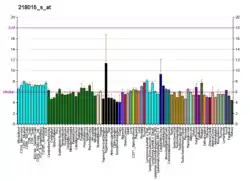WRNIP1
ATPase WRNIP1 is an enzyme that in humans is encoded by the WRNIP1 gene.[5][6] The protein is a member of AAA ATPase family.
Werner's syndrome is a rare autosomal recessive disorder characterized by premature aging. The protein encoded by this gene interacts with the N-terminal portion of Werner protein containing the exonuclease domain. This protein shows homology to replication factor C family proteins, and is conserved from E. coli to human. Studies in yeast suggest that this gene may influence the aging process. Two transcript variants encoding different isoforms have been isolated for this gene.[6]
Interactions
WRNIP1 has been shown to interact with Werner syndrome ATP-dependent helicase.[5]
References
- GRCh38: Ensembl release 89: ENSG00000124535 - Ensembl, May 2017
- GRCm38: Ensembl release 89: ENSMUSG00000021400 - Ensembl, May 2017
- "Human PubMed Reference:". National Center for Biotechnology Information, U.S. National Library of Medicine.
- "Mouse PubMed Reference:". National Center for Biotechnology Information, U.S. National Library of Medicine.
- Kawabe Yi, Branzei D, Hayashi T, Suzuki H, Masuko T, Onoda F, Heo SJ, Ikeda H, Shimamoto A, Furuichi Y, Seki M, Enomoto T (Jun 2001). "A novel protein interacts with the Werner's syndrome gene product physically and functionally". J Biol Chem. 276 (23): 20364–9. doi:10.1074/jbc.C100035200. PMID 11301316.
- "Entrez Gene: WRNIP1 Werner helicase interacting protein 1".
Further reading
- Maruyama K, Sugano S (1994). "Oligo-capping: a simple method to replace the cap structure of eukaryotic mRNAs with oligoribonucleotides". Gene. 138 (1–2): 171–4. doi:10.1016/0378-1119(94)90802-8. PMID 8125298.
- Suzuki Y, Yoshitomo-Nakagawa K, Maruyama K, et al. (1997). "Construction and characterization of a full length-enriched and a 5'-end-enriched cDNA library". Gene. 200 (1–2): 149–56. doi:10.1016/S0378-1119(97)00411-3. PMID 9373149.
- Strausberg RL, Feingold EA, Grouse LH, et al. (2003). "Generation and initial analysis of more than 15,000 full-length human and mouse cDNA sequences". Proc. Natl. Acad. Sci. U.S.A. 99 (26): 16899–903. doi:10.1073/pnas.242603899. PMC 139241. PMID 12477932.
- Mungall AJ, Palmer SA, Sims SK, et al. (2003). "The DNA sequence and analysis of human chromosome 6". Nature. 425 (6960): 805–11. doi:10.1038/nature02055. PMID 14574404.
- Ota T, Suzuki Y, Nishikawa T, et al. (2004). "Complete sequencing and characterization of 21,243 full-length human cDNAs". Nat. Genet. 36 (1): 40–5. doi:10.1038/ng1285. PMID 14702039.
- Beausoleil SA, Jedrychowski M, Schwartz D, et al. (2004). "Large-scale characterization of HeLa cell nuclear phosphoproteins". Proc. Natl. Acad. Sci. U.S.A. 101 (33): 12130–5. doi:10.1073/pnas.0404720101. PMC 514446. PMID 15302935.
- Gerhard DS, Wagner L, Feingold EA, et al. (2004). "The status, quality, and expansion of the NIH full-length cDNA project: the Mammalian Gene Collection (MGC)". Genome Res. 14 (10B): 2121–7. doi:10.1101/gr.2596504. PMC 528928. PMID 15489334.
- Rush J, Moritz A, Lee KA, et al. (2005). "Immunoaffinity profiling of tyrosine phosphorylation in cancer cells". Nat. Biotechnol. 23 (1): 94–101. doi:10.1038/nbt1046. PMID 15592455. S2CID 7200157.
- Tsurimoto T, Shinozaki A, Yano M, et al. (2005). "Human Werner helicase interacting protein 1 (WRNIP1) functions as a novel modulator for DNA polymerase delta". Genes Cells. 10 (1): 13–22. doi:10.1111/j.1365-2443.2004.00812.x. PMID 15670210. S2CID 24977510.
- Olsen JV, Blagoev B, Gnad F, et al. (2006). "Global, in vivo, and site-specific phosphorylation dynamics in signaling networks". Cell. 127 (3): 635–48. doi:10.1016/j.cell.2006.09.026. PMID 17081983. S2CID 7827573.
- Bish RA, Myers MP (2007). "Werner helicase-interacting protein 1 binds polyubiquitin via its zinc finger domain". J. Biol. Chem. 282 (32): 23184–93. doi:10.1074/jbc.M701042200. PMID 17550899.
This article is issued from Wikipedia. The text is licensed under Creative Commons - Attribution - Sharealike. Additional terms may apply for the media files.




